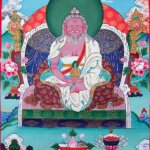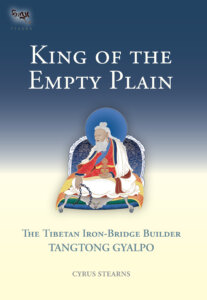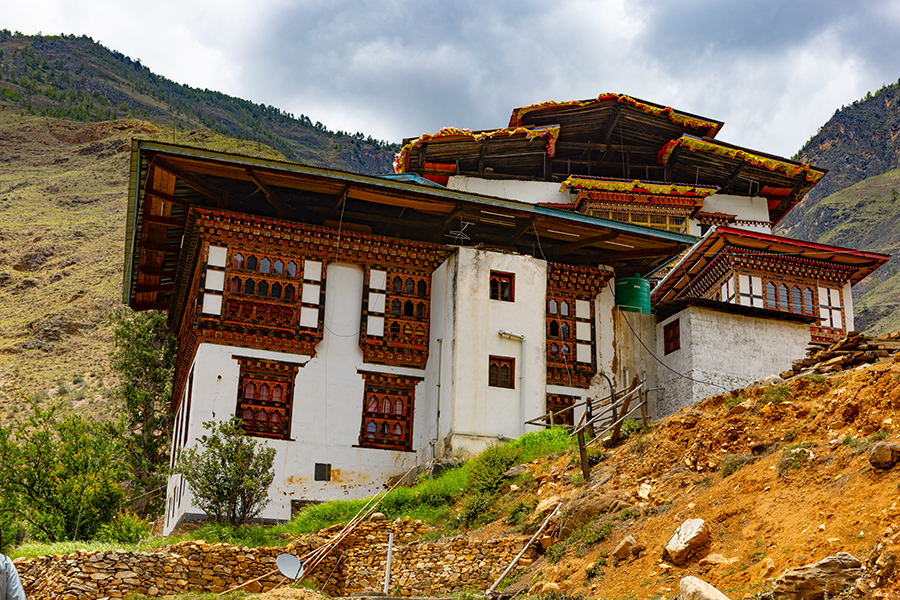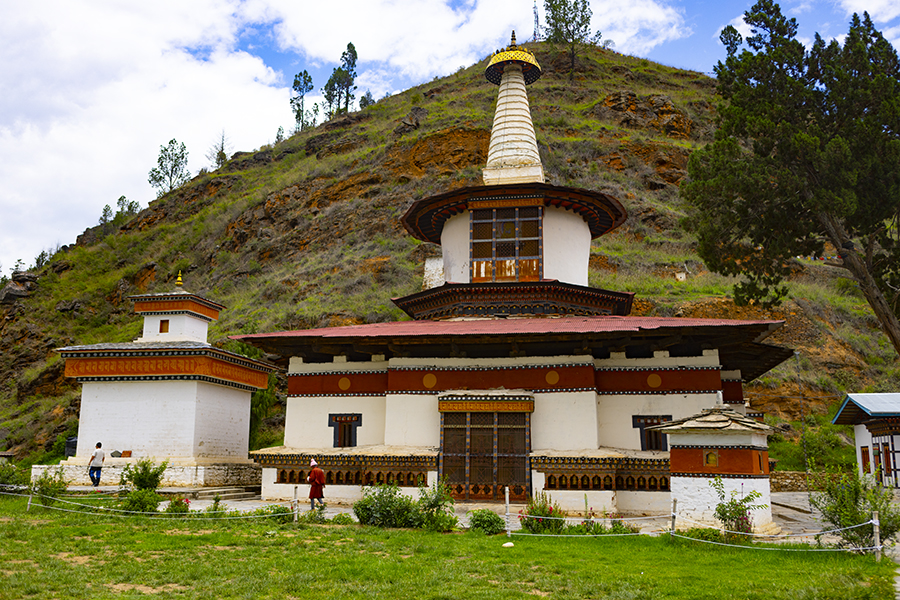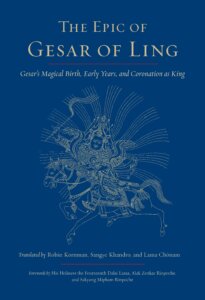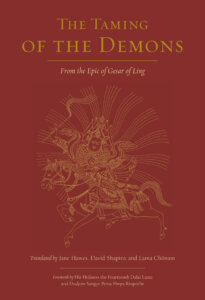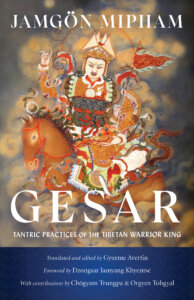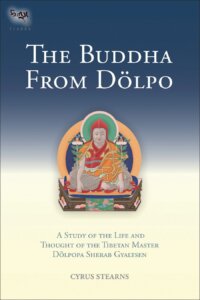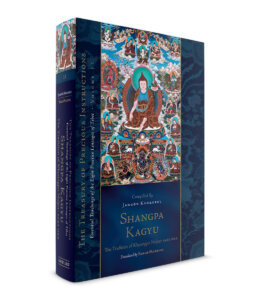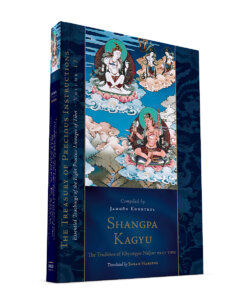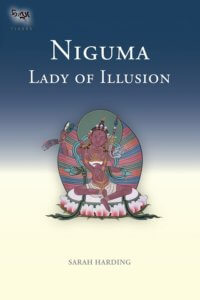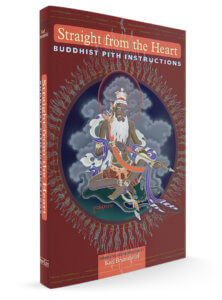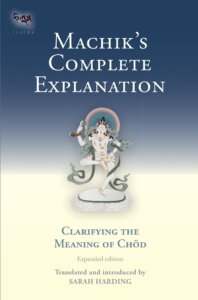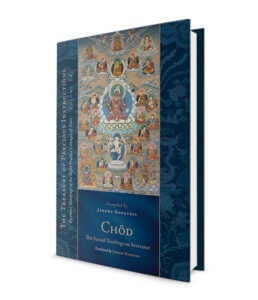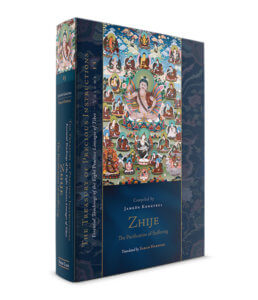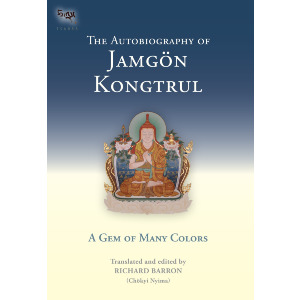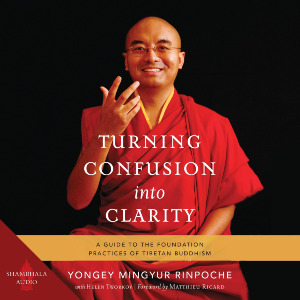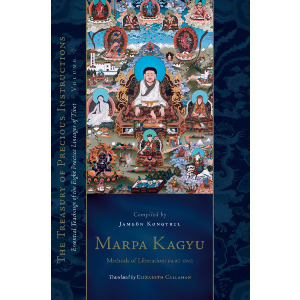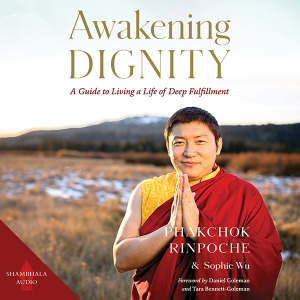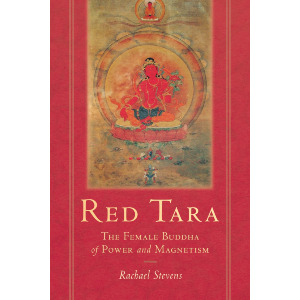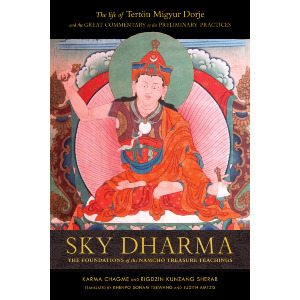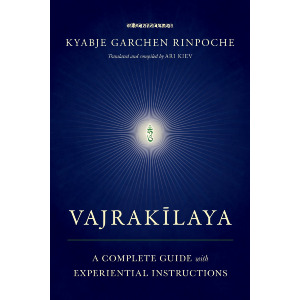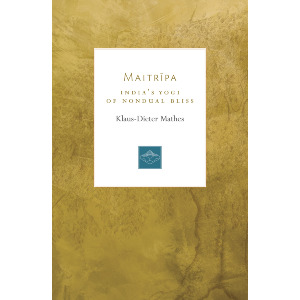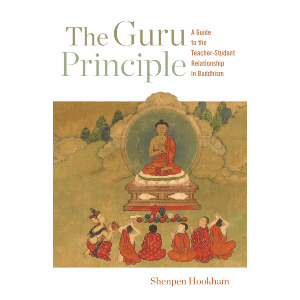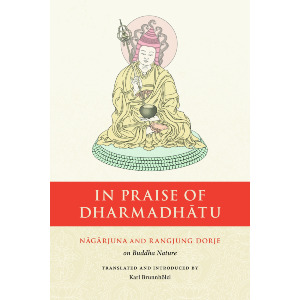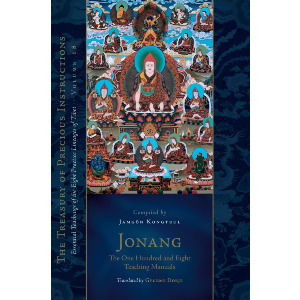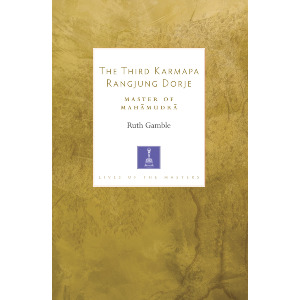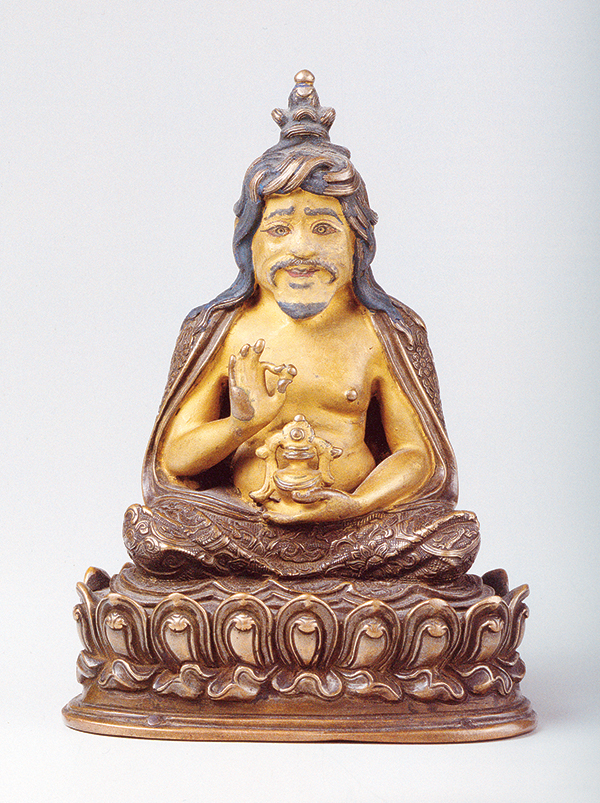
Tangtong Gyalpo (1361-1485 CE), or "The King of the Empty Plain," was a Buddhist mahasiddha, physician, blacksmith, architect, and civil engineer. He's also known by the names Chakzampa, the "Iron Bridge Builder," and Tsondru Zangpo, "Excellent Persistence." Many people believe he was an emanation of both Padmasambhava (known as "Guru Rinpoche" among Tibetan Buddhists) and Dolpopa Sherab Gyaltsen, the foremost master of shentong and a major proponent of the Jonang tradition. Aside from his architectural feats of building 58 iron chain suspension bridges and erecting several large stupas across Tibet and Bhutan, he is known for founding the Iron Chain lineage of the Shangpa Kagyu tradition.
Furthermore, he is known for developing lhamo or Tibetan theater in the 14th century and establishing song and dance troupes to raise money needed to build bridges. Performers would tell stories, recite mantra, and perform song and dance as a means to both teach and subdue demons for the sake of building Tangtong Gyalpo's bridges.
Lastly, Tangtong Gyalpo was known for his ability to eradicate disease. His famous prayer commonly known as "Thangtong Gyalpo's Refuge Prayer" is said to be helpful for averting adverse circumstances and transforming difficulty.
King of the Empty Plain
King of the Empty Plain is one of the most fascinating in-depth portrayals Tibetan master available. Tangtong Gyalpo's incredible lifespan, profound teachings, unprecedented engineering feats, eccentric deeds, and creation of Tibetan opera have earned this fascinating figure a unique status in Tibetan culture. Believed to be the great Indian master Padmasambhava appearing again in the world to benefit living beings, he discovered techniques for achieving longevity that are still held in highest esteem and are frequently taught six hundred years later. His construction of fifty-eight iron suspension bridges, sixty wooden bridges, 118 ferries, 111 stupa monuments, and countless temples and monasteries in Tibet and Bhutan remains an awe-inspiring accomplishment.
This book is a detailed study of the life and legacy of this great master. An extensive introduction discusses Tangtong Gyalpo's Dharma traditions, the question of his amazing longevity, his "crazy" activities manifested to enhance his own realization and to benefit others, and his astonishing engineering and architectural achievements. The book includes a complete translation of the most famous Tibetan biography of Tangtong Gyalpo, as well as the Tibetan text and English translation of a unique early manuscript describing his miraculous death. The text is further enriched with ten color plates and seventy-seven black-and-white illustrations.
Here is a short biographical sketch from King of the Empty Plain by Cyrus Sterns
Countless Buddhist teachers and practitioners have appeared over the centuries in the snowy land of Tibet. None have made a deeper impact on the combined religious, artistic, and technological history of the country than the great adept (mah›siddha, grub chen) Tangtong Gyalpo, “King of the Empty Plain” (Thang stong rgyal po, 1361?−1485). This heroic figure became legendary because of his contributions to the mystical traditions, his exceptionally long life, and his innovative achievements in the fields of art, architecture, and metallurgy. Tangtong’s life and teachings are intertwined with divine madness, visionary revelation, demon exorcism, the quest for immortality, the relationship of human beings with their environment, and the process of ultimate enlightenment. He is famous in Tibet and the Himalayan regions for building many iron suspension bridges and is thus known by the epithet “Iron-Bridge Man” (Lcags zam pa). The great master also constructed many stupas—architectural symbols of enlightened mind—that were strategically located according to geomantic principles in order to control the wild energy of the landscape. Several of his monasteries in Tibet and Bhutan are still famous at the beginning of the twenty-first century.
Tangtong Gyalpo is said to have lived 125 years as a result of his perfection of meditative techniques for achieving longevity. These methods have been passed down as the most efficacious and popular such practices in Tibetan Buddhism. His other systems of meditation, in particular those of Avalokitesvara and Vajravarahı, are still practiced after more than five hundred years. He is known as a mental emanation of Guru Padmasambhava and is believed to have recovered numerous caches of hidden treasure teachings (gter ma) concealed by the Indian master. His nonsectarian activities and teachings have earned him a special position in all the Buddhist traditions of Tibet.
Sterns also writes that Tangtong Gyalpo is represented as a sorcerer-type character in the popular Tibetan epic, Gesar:
Tangtong Gyalpo was also called “Madman of the Empty Valley” (Lung stong smyon pa), one of five names given to him by the dakinis in recognition of his spiritual attainments. This title indicates that he was one of the most important of the “mad adepts” who have been prominent in Tibetan history. He is remembered today as a charismatic figure of dark maroon complexion with long white hair and beard, dressed only in a single cloak, provocative in both appearance and behavior. His reputation as a formidable sorcerer is clearly retained in the popular Gesar legends, where he is identified with the White Old Man, while the tradition of his attainment of immortality is reflected in the opera performances of the Aché Lhamo, which he is said to have created as entertainment for the people while his iron bridges were being built.
Tangtong Gyalpo as the Reincarnation of Dolpopa
Cyrus Stearns also wrote The Buddha from Dolpo: A Study of the Life and Thought of the Tibetan Master Dolpopa Sherab Gyaltsen . Tangtong Gyalpo was considered a rebirth of Dolpopa and unsurprisingly features in this book as well.
Tangtong Gyalpo and the Shangpa Kagyu Tradition
Shangpa Kagyu is a Tibetan school founded by the 11th century master, Khyungpo Naljor after receiving teachings and revelations from two dakinis: Niguma and Sukhasiddhi. Tangtong Gyalpo is among the masters who upheld the tradition along with others such as Jetsün Taranatha and Jamgon Kongtrul Lodro Taye, who compiled a collection of teachings from the Eight Great Practice Lineages of Tibet including Shangpa Kagyu. This 18 volume collection is called The Treasury of Precious Instructions. Shangpa Kagyu makes up volumes 11 and 12.
Specifically, Volume 12 (ie., Part 2 of the Shangpa Kagyu volumes) includes several essential writings from Tangtong Gyalpo including Collection of Essentials: Vital Words of Instruction on the Six Dharma of Niguma, Dakini of Timeless Awareness and a number of auxiliary practices and teachings from Niguma.
Shangpa Kagyu: The Tradition of Khyungpo Naljor, Part One
By Jamgon Kongtrul Lodro Taye
Translated by Sarah Harding
About this volume:
Volume 11 of the series, Shangpa Kagyu, is the first of two volumes that present a selection of teachings and practices from the Shangpa practice lineage of Tibetan Buddhism. This tradition was established in Tibet by the eleventh-century yogi Khyungpo Naljor, who had received profound esoteric teachings from many great Indian masters, especially the two yoginīs Niguma and Sukhasiddhi, as well as Maitrīpa, Rāhula, and Vajrāsana.
Shangpa Kagyu: The Tradition of Khyungpo Naljor, Part Two
By Jamgon Kongtrul Lodro Taye
Translated by Sarah Harding
About this volume:
This is the second of two volumes that present teachings and practices from the Shangpa Kagyu practice lineage of Tibetan Buddhism. This tradition derives from two Indian yoginīs, the dākinīs Niguma and Sukhasiddhi, and their disciple, the eleventh-century Tibetan yogi Khyungpo Naljor Tsultrim Gönpo of the Shang region of Tibet.
Related Books from Shangpa Kagyu
About this book:
Providing a rare glimpse of feminine Buddhist history, Niguma, Lady of Illusion brings to the forefront the life and teachings of a mysterious eleventh-century Kashmiri woman who became the source of a major Tibetan Buddhist practice lineage. The circumstances of her life and extraordinary qualities ascribed to her are analyzed in the greater context of spiritual biography and Buddhist doctrine. More than a historical presentation, Niguma's story raises the question of women as real spiritual leaders versus male images of feminine principle and other related contemporary issues. This volume includes the thirteen works that have been attributed to Niguma in the Tibetan Buddhist canon.
Songs and Prayers by Tangtong Gyalpo
Tangtong Gyalpo wrote a number of prayers, poems, and songs of realization throughout his life. The most well-known prayer is called Drubchen tangtong gyalpö tukdam chi nang sangwé kyab dro or, The Outer, Inner, and Secret Refuge Practice of the Mahāsiddha Thangtong Gyalpo. According to the colophon
"This prayer carries the blessing of Avalokiteśvara, who transmitted it to the Lord of Dharma Ka Ngapa and told him to give it to Gelong Tsöndru Zangpo (Thangtong Gyalpo), saying that if he taught it to the people of this world, it would dispel all sickness, negative influences and obstacles right now, and then also grant protection from the lower realms."
This prayer is still used today by Tibetan Buddhist practitioners of various lineages.

The Outer, Inner, and Secret Refuge Practice of the Mahāsiddha Tangtong Gyalpo
མ་ནམ་མཁའ་དང་མཉམ་པའི་སེམས་ཅན་ཐམས་ཅད་བླ་མ་སངས་རྒྱས་རིན་པོ་ཆེ་ལ་སྐྱབས་སུ་མཆིའོ། །
ma namkha dang nyampé semchen tamché lama sangye rinpoche la kyab su chi o
All mother sentient beings as infinite as space take refuge in the guru, the precious buddha.
སངས་རྒྱས་ཆོས་དང་དགེ་འདུན་རྣམས་ལ་སྐྱབས་སུ་མཆིའོ། །
sangye chö dang gendün nam la kyab su chi o
In the Buddha, Dharma and Saṅgha, we take refuge.
བླ་མ་ཡི་དམ་མཁའ་འགྲོའི་ཚོགས་ལ་སྐྱབས་སུ་མཆིའོ། །
lama yidam khandrö tsok la kyab su chi o
In the assembly of gurus, yidam deities and ḍākinīs, we take refuge.
རང་སེམས་སྟོང་གསལ་ཆོས་ཀྱི་སྐུ་ལ་སྐྱབས་སུ་མཆིའོ། །
rangsem tongsal chö kyi ku la kyab su chi o
In the dharmakāya, the inseparable emptiness and clarity of our own minds, we take refuge.
Songs for Tangtong Gyalpo
In Karl Brunnhölzl's collection, Straight From the Heart: Buddhist Pith instructions, there are numerous poems for and dedicated to Tangtong Gyalpo including the following prayer of devotion to Tangtong Gyalpo by Khamba Deleg Bal:
O father, qualified and precious guru,
Man of iron bridges whose name is so well-renowned,
Nirmanakaya of all the Buddhas,
Amazing one named by the dakinis,There are many gurus whose faces I have seen,
But uncontrived devotion was never before born in me.
Now that I have met you, a guru who is a Buddha,
I supplicate you to give me the pith instructions.
About this Book:
Straight from the Heart brings together an inspiring collection of Buddhist teachings, songs of realization, meditation instructions, and enlightened poetry—all chosen for their power to speak directly to the student. Drawn from Indian Mahayana and Vajrayana Buddhism as well as from all four schools of Tibetan Buddhism, some will impress with their beautiful poetry and powerful imagery, others with their profound power of instruction.
Tangtong Gyalpo and the Chöd Tradition
Chöd is a traditional Tibetan Buddhist and Bon practice that's based on the teachings of the Prajñapāramitā or Perfection of Wisdom Sutras. Often translated as "cutting through," chöd emphasizes realizing emptiness—the ultimate nature of reality.
Tangtong Gyalpo was a chöd master known for practicing chöd before initiating construction projects for the sake of warding off inner and outer obstacles.
In King of the Empty Plain, Cyrus Sterns writes:
The most closely guarded esoteric teachings of Tangtong Gyalpo concern the practice of Chöd, or Severance, about which he never wrote. During the course of his studies and travels, Tangtong studied all the systems of Chöd in Tibet. From Lhadongpa Sönam Chokpa, he received the transmission of the Chöd practices taught by Padmasambhava and passed down in the Northern Treasure tradition of the Nyingma School, which were based on the treasures of Gökyi Demtruchen (1337−1408). However, it was a vison of Vajrāvārahī appearing to Tangtong as Machik Labdrön (eleventh–twelfth centuries) in the Kashmiri cemetery of Rāmeśvara that was to be most significant. Machik Labdrön was the mother of the most influential Chöd system in Tibet, and the visionary teachings she transmitted to Tangtong form the basis of Tangtong’s Oral Transmission (Thang stong snyan brgyud), also known as the Oral Transmission of Machik’s Secret Behavior (Ma gcig gsang spyod snyan brgyud), which has been passed down without interruption to the present day. Tangtong specifically practiced Chöd to bring the local spirits under his control long before beginning his first construction projects.
Related Books from the Tibetan Buddhist Tradition
Related Articles
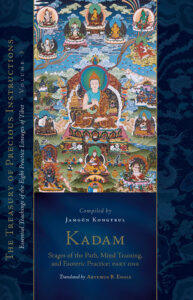
Bodhisattva’s Jewel Garland: An Excerpt from Kadam, Part One
Bodhisattva's Jewel Garland: A Root Text of Mahāyāna Instruction from the Precious Kadam Scripture Excerpted from Kadam: Stages of the Path, Mind Training, and Esoteric Practice, Part One...
Tibetan Buddhist Books in 2023: A Review
See our other Year in Review Guides: Zen and Chan | Tibetan Buddhism | More in Buddhism Yoga | Kids Books...

Tibetan Masters of the 10th-11th Centuries
See Also: Profiles of early Indian Mahayana figures | Tibetan Masters of the 8th Century | Tibetan Masters of the 10th-11th Centuries...
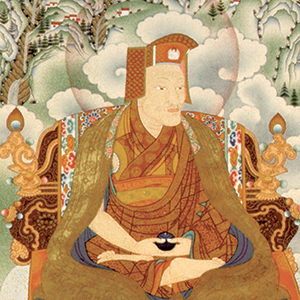
Gampopa: A Guide for Readers Related Reader Guides:...

